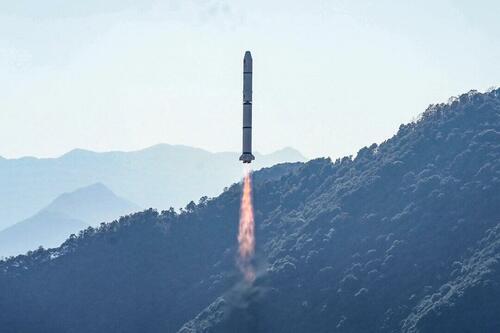
Китай запускает собственную версию Starlink, чтобы бросить вызов доминированию США в космосе
Автор: Джон Сун и Майкл Чжуан через The Epoch Times (выделение наше),
В своей последней попытке бросить вызов космическому доминированию Соединенных Штатов и Starlink SpaceX. Китай запустил низкоорбитальную спутниковую группировку, способную контролировать каждый уголок Земли.
 Ракета Long March-2C, несущая спутник Einstein Probe, взлетает из Центра запуска спутников Xichang в Сычане, в юго-западной китайской провинции Сычуань 9 января 2024 года.
Ракета Long March-2C, несущая спутник Einstein Probe, взлетает из Центра запуска спутников Xichang в Сычане, в юго-западной китайской провинции Сычуань 9 января 2024 года.По данным китайских СМИ, Первая партия из 18 спутников в созвездии, получившая название «Цяньфан» или «тысяча парусов», была запущена на орбиту государственной компанией Shanghai Yuxin Satellite Technology Company. 6.6. Весь проект является Будущая сеть из 14 000 спутников, предлагая несколько услуг, включая подключение напрямую к устройству. Половина этих космических аппаратов будет запущена к концу следующего года, а другая половина — к концу 2027 года.
Starlink, принадлежащая американской компании SpaceX, предоставила Украине услуги интернета и связи, что является важным элементом для поддержания страны в ее войне с Россией. По состоянию на 2 августа сеть насчитывала около 7000 спутников на орбите, что делает ее крупнейшим низкоорбитальным созвездием в мире.
Возможности Starlink привлекли внимание Министерства обороны США, которое заключило контракт с SpaceX в 2021 году на создание сети спутников, известных как Starshield, для обслуживания оборонных и разведывательных агентств Америки.
Коммунистическая партия Китая (КПК) также обратила на это внимание.
В апреле газета режима PLA Daily, официальная газета Народно-освободительной армии КПК, обвинила Соединенные Штаты в милитаризации космоса. "
Китайские военные исследователи проанализировали различные возможности Starlink в 2022 году. Они писали, что Starlink представляет «потенциальные опасности и вызовы» для КПК. Исследователи призвали режим разработать новые контрмеры, которые включали бы способность отключать некоторые спутники Starlink и нарушать оперативную систему созвездия. "
В прошлом году ученые из Университета аэрокосмической инженерии, исследовательского университета НОАК, предложили методы «подавления» связи Starlink и Starshield. Включая электромагнитные помехи и использование мощных микроволн или лазеров для повреждения или уничтожения определенных спутников Starlink.
Кроме того, китайские оборонные журналы проанализировали украинские операции и потенциальное использование американских технологий, включая Starlink, в будущей войне против Тайваня, согласно отчету Reuters в 2023 году.
Генерал Стивен Н. Уайтинг, глава Космического командования США, предупредил в апреле, что достижения Китая в космосе были «поразительно быстрыми». "
Космические амбиции и проблемы КПК
Проект Qianfan Constellation не был первой попыткой КПК.
Запуск спутников Starlink в 2019 году ознаменовал введение системы спутникового интернета с глобальным охватом, которая представляет потенциальную угрозу для китайского интернет-брандмауэра. Starlink может предложить Китаю услуги, которые могут обойти текущую интернет-цензуру КПК. Илон Маск заявил в 2022 году, что китайский режим попросил его не продавать Starlink в Китае.
В следующем году КПК представила «GW» — акроним для Го Вана или национальной сети — интернет-план созвездия Международному союзу электросвязи (МСЭ).Планируется вывести на низкую орбиту около 13 тысяч спутников. Однако план ГВ был медленным и не смог стать первым запуском спутников для КПК.
В рамках проекта Qianfan Constellation КПК захватывает низкоземную орбиту (LEO) и частотные ресурсы, которые в настоящее время контролируются Международным союзом электросвязи (МСЭ) на основе «первого прихода, первого обслуживания», для создания своей сетевой системы. Из-за его более близкого расстояния к Земле, LEO выгодно в визуализации, связи и обмене информацией в реальном времени на поле боя.
Си-фу Оу, старший научный сотрудник и директор отдела китайской политики, военных и боевых концепций в Тайваньском институте исследований национальной обороны и безопасности, сказал The Epoch Times, что Развитие спутниковой группировки Китая осуществляется в военных целях.
Он сказал, что противоспутниковые возможности КПК уже реальны и будут продолжать развиваться. Однако, учитывая текущую технологическую и военную мощь Соединенных Штатов, китайская спутниковая группировка вряд ли догонит Соединенные Штаты в краткосрочной перспективе.
Цуннань Лин, профессор электротехники в Национальном университете Тайваня, сказал The Epoch Times, что инвестиции Китая в Цяньфан демонстрируют амбиции режима по развитию «китайского Starlink», несмотря на текущий экономический спад в стране. Китайская экономика была омрачена угрозами дефляции, сокращением экспорта и рынками недвижимости с крупной задолженностью и местными органами власти.
"Эти усилия направлены на то, чтобы продемонстрировать свои возможности самодостаточности и подготовиться к потенциальным конфликтам с Соединенными Штатами.- сказал Лин.
Синь Нин внес свой вклад в доклад.
Тайлер Дерден
Фри, 08/16/2024 - 12:20












